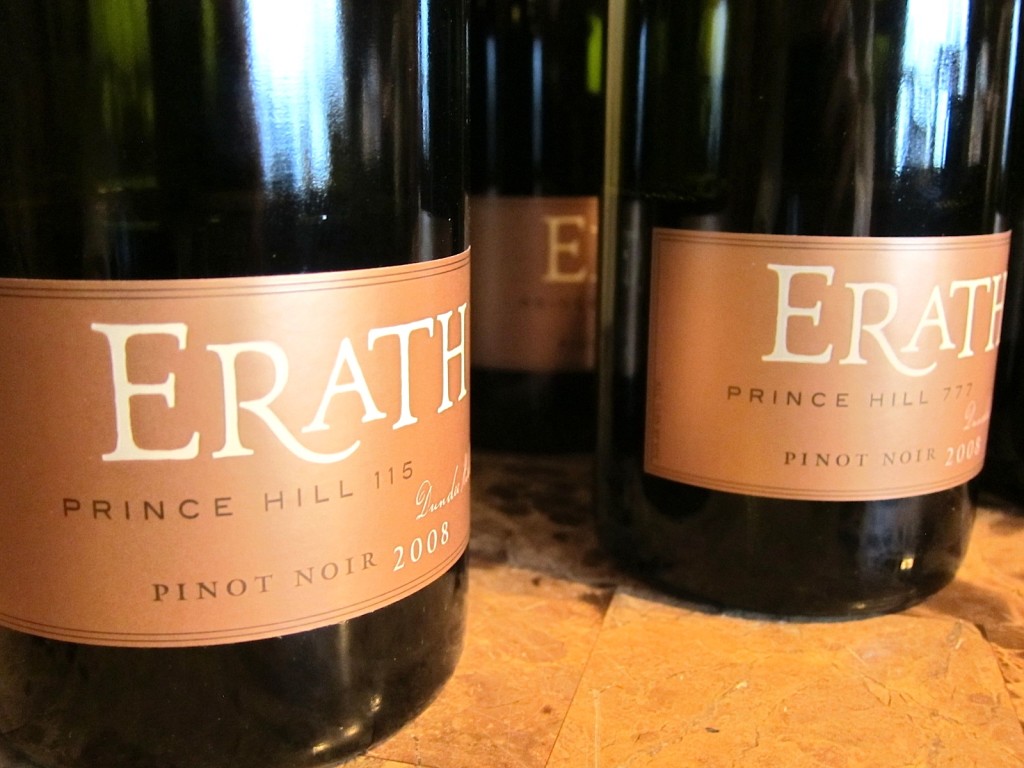
While in Washington with Ste. Michelle Wine Estates, traveling as their guest on their “string of pearls” wine tour, after visiting their ColSolare and Northstar Wineries we visited Spring Valley Vineyards and then moved down to Oregon to Erath.
One of the first wineries I fell in loved with when I started learning about the wines of Eastern Washington was Spring Valley Vineyards. My husband and I had taken a trip to the area for a Dave Mathews concert at The Gorge and stayed a few extra days to check out Walla Walla. As we strolled through the charming town we happened upon the Spring Valley tasting room right in downtown Walla Walla. After one sip of the wines I was hooked…add in generations of history tied to the area, with a family that has worked the land with the utmost respect and dedication since the mid-1800’s and it is impossible not to celebrate them. The Spring Valley family, starting with Uriah Corkrum and moving on to his daughter Shari and husband Dean Derby, now on to Kate, their grand-daughter, has been in the region for decades as wheat farmers that only recently planted vines on their expansive estate.
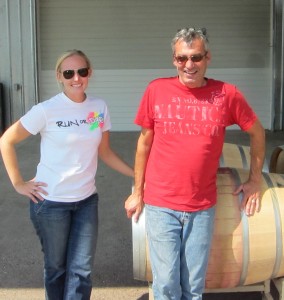
In 1897 Uriah Corkrum purchased the ranch at Spring Valley just outside of downtown Walla Walla to grow wheat. Fast forward almost 100 years to 1993 when Uriah’s granddaughter Shari Corkrum Derby and her husband Dean decided to plant grape vines on part of the expansive estate, but only part as the ranch is still successfully growing wheat and managing cattle. Shari and Dean’s son Devin Corkrum Derby moved home to the ranch and became winemaker until his untimely death in 2004. Devin’s assistant and friend Serge Laville became head winemaker and continues in this role today, now with the assistance of Devin’s daughter Kate, who also runs the day to day operations of the ranch at Spring Valley, with her grandparents Dean and Shari still involved and living on the property.
At that dinner when I met Ste. Michelle CEO Ted Baseler he told me the story of how Ste. Michelle got involved with Spring Valley. Dean Derby was sitting next to a gentleman on a cross country flight and the two started talking, initially just chit-chat, eventually Dean mentioned he is the wine business in the Northwest and the gentleman saying he was as well, which opened a great discussion about wine, the Northwest and Spring Valley. At the end of the flight Ted says to him if he is ever looking to expand or needs help to give him a call. It was at that point that Dean realized he was talking to the CEO of Chateau St. Michelle, who he would eventually go into business with just a short time later. Ste. Michelle acquired the winery in 2005 not long after Devin’s death, giving Ste. Michelle an impressive addition to their string of pearls with completely estate grown Walla Walla wine, and helped Dean and Shari (then in their 70’s) figure out what to do with vineyards and a winery they had never really planned on running themselves. The Derby family still runs the farm, Ste. Michelle handles the wine.
 The passion and love for the vines and this land is evident while walking the estate vineyards with Serge and Kate, as well as the pride each has in the work that they do. Set in the midst of 1000 acres of land, predominantly filled with just harvested wheat fields, are 40 acres of lush Merlot, Syrah, Cabernet Sauvignon, Petit Verdot, Malbec and Cabernet Franc vines, many still going through verasion as the ranch sits in one of the coolest parts of the region. The soils are also quite fertile, requiring some of the initial vineyards planted by Dean and Sheri in the 1990’s with double high cordon trellises, or with two trellised cordons (or arms of the vines) sitting one on top of the other to create two curtains of vines, a method for training vines ideally suited for highly fertile soil. Vines are also planted in vertical rows on a north-south facing slope to ensure ideal air flow and ample sunshine. Each of the vines of the now 111 acres on the estate are tended by hand in each phase of development from bud break in the spring to eventual harvest in the fall.
The passion and love for the vines and this land is evident while walking the estate vineyards with Serge and Kate, as well as the pride each has in the work that they do. Set in the midst of 1000 acres of land, predominantly filled with just harvested wheat fields, are 40 acres of lush Merlot, Syrah, Cabernet Sauvignon, Petit Verdot, Malbec and Cabernet Franc vines, many still going through verasion as the ranch sits in one of the coolest parts of the region. The soils are also quite fertile, requiring some of the initial vineyards planted by Dean and Sheri in the 1990’s with double high cordon trellises, or with two trellised cordons (or arms of the vines) sitting one on top of the other to create two curtains of vines, a method for training vines ideally suited for highly fertile soil. Vines are also planted in vertical rows on a north-south facing slope to ensure ideal air flow and ample sunshine. Each of the vines of the now 111 acres on the estate are tended by hand in each phase of development from bud break in the spring to eventual harvest in the fall.
 The result – refined, elegant, site specific wines reflecting their terroir, each named after a member of the family. Their flagship, Uriah, named after Spring Valley founder, blending the signature Washington Merlot together with Cabernet Franc, Petit Verdot, Cabernet Sauvignon and a touch of Malbec creating a red fruit, herb and floral filled wine layered with touches of leather, spice and vanilla from its 18 months of aging in French oak, 60% of which is new.
The result – refined, elegant, site specific wines reflecting their terroir, each named after a member of the family. Their flagship, Uriah, named after Spring Valley founder, blending the signature Washington Merlot together with Cabernet Franc, Petit Verdot, Cabernet Sauvignon and a touch of Malbec creating a red fruit, herb and floral filled wine layered with touches of leather, spice and vanilla from its 18 months of aging in French oak, 60% of which is new.
Spring Valley’s Cabernet Sauvignon blend is named after Uriah’s son, Fredrick, a former football star and muleskinner on the ranch. A bolder, slightly more robust wine than the Uriah, perhaps an indication of the differences between father and son, 55% Cabernet Sauvignon blended with 29% Cabernet Franc, 18% Merlot and 8% Petit Verdot creating a black licorice, juicy black and blueberry, and black cherry filled wine with well structured tannins, balanced acidity and a lush finish.
 My favorite of the Spring Valley wines is named after Uriah’s wife Katherine, who current ranch manager Kate is named after. Katherine is predominantly Cabernet Franc (90%), a variety that does very well in the Washington soils and climate, ripening to create fruit filled with notes of rose petals, fresh herbs, berries and cassis. A touch of Merlot and Petit Verdot are blended into the wines to add structure and color. Aged in 100% new French oak for 18 months the overall result is a wine filled with sweet spice and toasted oak, dark cherry, dried herbs and floral notes and a silky finish.
My favorite of the Spring Valley wines is named after Uriah’s wife Katherine, who current ranch manager Kate is named after. Katherine is predominantly Cabernet Franc (90%), a variety that does very well in the Washington soils and climate, ripening to create fruit filled with notes of rose petals, fresh herbs, berries and cassis. A touch of Merlot and Petit Verdot are blended into the wines to add structure and color. Aged in 100% new French oak for 18 months the overall result is a wine filled with sweet spice and toasted oak, dark cherry, dried herbs and floral notes and a silky finish.
Though each of the Spring Valley wines is different and unique on their own, their overall similarity in style, character and complexity drifts through each stemming from the richness of the soil, the refrained touch of its winemaker, and the respect of the family who has farmed this land for generations.
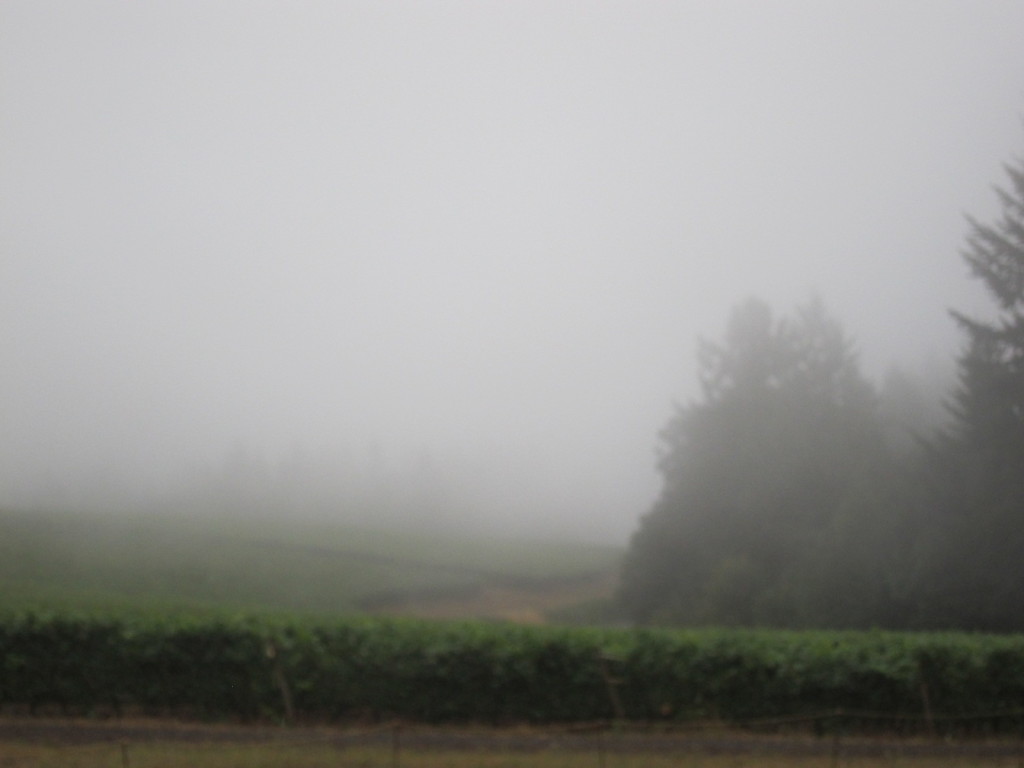
Dick Erath began his Willamette Valley winery some 40+ years ago, one of the first in the area and a pioneer for helping define the region as ideal Pinot Noir land. At the time it is unlikely he could have imagined how successful the region, and his wines, would become world wide. Acquired by Ste. Michelle in 2006 and led by Winemaker Gary Horner, this year celebrating his 10 year anniversary with the winery, starting out working directly under Dick Erath in 2003. Since then Erath has continued to elevate themselves, specifically for me with their single vineyard estate wines from the mineral rich Dundee Hills. And though Dick isn’t involved with the day to day activities of his namesake winery, Gary can still convince him to come down from his home atop the Prince Hill Estate Vineyard to taste the blends for the upcoming years release.

On the 45 minute drive down from Portland to the heart of Willamette Valley I am reminded of the first time I had Erath wine at Portland City Grill overlooking the lights of downtown Portland at night. This was at least 12 years ago while visiting Portland and Willamette for the first time. From the first sip of their easy drinking, orange label Oregon Pinot Noir I knew this was a region I was going to love. Today was no exception. Arriving in Willamette, on a very Northwest weather day (a complete climate change from the sunshine and heat of Eastern Washington to a foggy morning in Willamette with slightly cooler temperatures) the air feels like Pinot, as the finicky grape that needs to be handled with kid gloves to ensure berries aren’t ruined by mildew or mold.
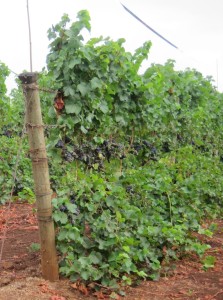
Over the years Erath has become a pro at tending their precious vines, removing excess foliage to ensure grapes get enough of a breeze to prevent mildew from forming, while also keeping enough of a canopy on the grapes to prevent sunburn on the occasional sunshine filled days in late summer. The similarities between Willamette and Burgundy were not lost on Dick Erath, or his neighbors and friends who started in the region about the same time like Ponzi, Adelsheim and David Lett at Eyrie, quickly realizing that the soil and climate were perfect for this much loved grape, but it was going to take a lot of work to do it right. And then, when you do have the right conditions, you have to figure out what type of Pinot Noir you want to grow, as all may do well in the area, but what does one winemaker have verses another to distinguish themselves – different clones.
Clones have also become the topic in Willamette, as in other parts of the world growing grapes, with winemakers bottling single vineyard, single clones to help customers better understand why certain clones work in certain parts of the vineyard or region. As a wine lover I love this level of detail, as each individual clone from a specific vineyard or even specific blocks of land withing a vineyard will have a very individual taste profile. The Pommard clone from France is one of the most widely used clones within the Willamette Valley region, and to me really defines the wine of the area that I have loved for years. Earthy, raspberry, strawberry and cherry with varying levels of minerality and spice depending on where the vines are planted or how the wine is aged. A Dundee Hills Pommard Clone Pinot will taste different than that from Yamhill-Carlton or Newberg.
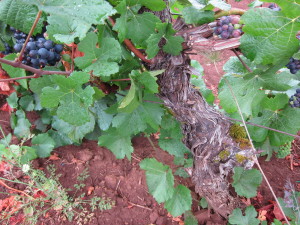
Erath’s vineyards are located throughout the Dundee Hills, what some consider to be the best soils in Willamette, with the winery keeping their focus on the richness, minerality and true fruit expression the red volcanic Jory soils give their fruit. Gary has a delicate touch with his wines, letting the fruit shine through instead of using a lot of oak. This approach ensures a freshness, fruit forward character and balance in his wines, often combining several different clones like Pommard, 777 and 667 together for a layered and elegant wine, with each clone adding a different flavor or structure element to the wines, and making creating the final blend the most time consuming work of all that he does as just an extra bit of one or another can drastically change the entire flavor profile of the wine.
Erath Prince Hill Pinot Noir brings expressive levels of red cherry, fresh raspberry, cranberry and pomegranate flavors to the forefront with a touch of tangerine zest, sweet baking spice and dried violets with balanced acidity and well structured tannins that are ready to drink upon release, but also have the ability to age for some time.
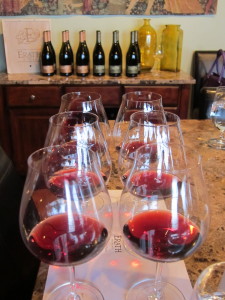 We had a chance to taste the main clones that go into the Prince Hill Pinot Noir, all from fruit grown on the Dundee Hills just in front of Dick Erath’s home. Typically the clones are planted right next to each other in the vineyard, but they must usually be harvested differently as one clone may ripen earlier than another. Prince Hill Pommard clone is typically the backbone of the wine with structure and depth, the clone that gives acidity, and elegance to a wine. Clone 115 adds layers of earthiness, tannin, spice and black fruit with good structure and intensity. Clone 777 is like the labrador of Pinot Noir clones, the big, brassy, bold clone with big fruit forward flavors of red cherry and red berry, slightly floral characteristics and a hint of spice. Each lacking a bit on their own, but when combined create a well rounded, layered and interesting wine with personality.
We had a chance to taste the main clones that go into the Prince Hill Pinot Noir, all from fruit grown on the Dundee Hills just in front of Dick Erath’s home. Typically the clones are planted right next to each other in the vineyard, but they must usually be harvested differently as one clone may ripen earlier than another. Prince Hill Pommard clone is typically the backbone of the wine with structure and depth, the clone that gives acidity, and elegance to a wine. Clone 115 adds layers of earthiness, tannin, spice and black fruit with good structure and intensity. Clone 777 is like the labrador of Pinot Noir clones, the big, brassy, bold clone with big fruit forward flavors of red cherry and red berry, slightly floral characteristics and a hint of spice. Each lacking a bit on their own, but when combined create a well rounded, layered and interesting wine with personality.
Gary’s hope when you taste his wines is that you can recognize the place that they come from, not the oak they were aged in. He longs for consistency and approachability in his wines and achieves this by maintaining the same techniques and procedures each year with his wine, so if there is a difference from one year to the next it is because of the type of year Mother Nature gave them not because of internal changes within the winery. Something has to be working as the winery continues to earn 90+ point ratings each year for both their elegant single vineyard wines and their expressive estate wine portfolio.


